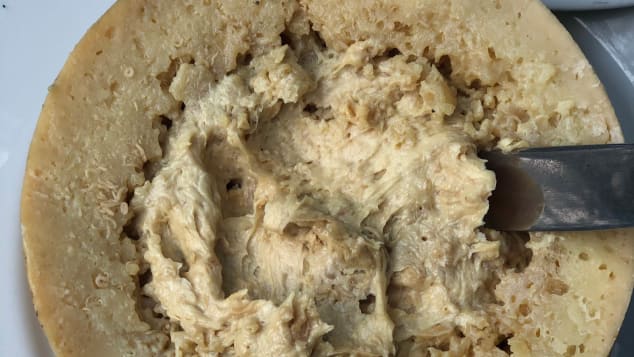Meet the most dangerous cheese in the world 0:55
(CNN) -
The Italian island of Sardinia sits in the middle of the Tyrrhenian Sea, looking at Italy from a distance.
Surrounded by a 1,849 kilometer coastline of white sand beaches and emerald waters, the island's inland landscape rises rapidly to form waterproof hills and mountains.
And it is within these curves that shepherds produce casu marzu, a worm-infested cheese that, in 2009, the Guinness World Record proclaimed the most dangerous cheese in the world.
What is the healthiest cheese?
These are the best options, according to experts
Cheese flies,
Piophila casei
, lay their eggs in the cracks that form in the cheese, usually fiore sardo, the island's salty pecorino.
The worms hatch, work their way through the pasta, digest the proteins in the process and transform the product into a smooth creamy cheese.
Then the cheesemaker opens the top - which has hardly been touched by the worms - to scoop out a spoonful of the creamy delicacy.
advertising
This is not a time for the weak.
At this point, the larvae inside begin to squirm frantically.
Some locals spin the cheese through a centrifuge to fuse the worms with the cheese.
Others like it naturally.
They open their mouths and eat everything.
Casu marzu is made with sheep's milk.
Credit: Sean Gallup / Getty Images
If you can overcome the understandable disgust, marzu has an intense flavor with hints of Mediterranean grasses and a spicy aftertaste that lingers for hours.
Some say it is an aphrodisiac.
Others say it could be dangerous to human health, as the worms could survive the bite and create myiasis, micro-perforations in the intestine, but so far, no such cases have been linked to casu marzu.
Cheese is banned from commercial sale, but Sardinians have consumed it, including jumping larvae, for centuries.
"The worm infestation is the spell and delight of this cheese," says Paolo Solinas, a 29-year-old Sardinian gourmet.
The 'best cheese in the world' 2021 is Spanish
He says some Sardinians shudder at the thought of casu marzu, but others who have been raised a salty pecorino life unabashedly love its strong flavors.
"Some shepherds view cheese as a unique personal treat, something that only a select few can taste," adds Solinas.
Archaic kitchen
It is illegal to sell or buy casu marzu.
Credit: Giovanni Fancello
When tourists visit Sardinia, they usually end up in a restaurant serving Sardinian porceddu, a slow-roasted suckling pig, visit bakers selling pane Caraau, a traditional paper-thin bread, and meet shepherds who produce Sardinian fiore, Pecorino cheese. of the island.
However, if you are adventurous enough, it is possible to find the casu marzu.
It should not be seen as a strange attraction, but rather as a product that keeps an ancient tradition alive and hints at what the future of food might look like.
Giovanni Fancello, a 77-year-old Sardinian journalist and gourmet, spent his life researching the history of local food.
It dates back to a time when Sardinia was a province of the Roman Empire.
"Latin was our language and it is in our dialect that we find traces of our archaic cuisine," says Fancello.
Do you like insects?
Season worms, beetles and spiders
There is no written record of Sardinian recipes until 1909, according to Fancello.
It was then that Vittorio Agnetti, a doctor from the mainland of Modena, traveled to Sardinia and compiled six recipes in a book called "La nuova cucina delle specialità regionali".
"But we have always eaten worms," says Fancello.
"Pliny the Elder and Aristotle talked about it."
Ten other Italian regions have their worm-infested cheese variant, but while products elsewhere are considered unique, casu marzu is intrinsically part of Sardinian food culture.
The cheese has several different names, such as casu becciu, casu fattittu, hasu muhidu, formaggio marcio.
Each subregion of the island has its own way of producing it using different types of milk.
"Magical and supernatural events"
Foodies inspired by the exploits of chefs like Gordon Ramsay often come in search of cheese, says Fancello.
“They ask us: 'How is casu marzu made?'
It's part of our history.
We are the children of this food.
It is the result of chance, of magical and supernatural events. "
Fancello grew up in the town of Thiesi with his father Sebastiano, who was a shepherd who made casu marzu.
Facello led his family's sheep to the pastures around the rural area of Mount Ruju lost in the clouds where magic was believed to occur.
Remember that, for his father, the casu marzu was a divine gift.
If your cheeses weren't infested with worms, I'd be desperate.
Some of the cheese that was produced stayed for the family, others went to the hands of friends or people who requested it.
Casu Marzu is typically produced in late June, when local sheep's milk begins to change as the animals enter their breeding season and the grass dries up from the summer heat.
The seaside town of Alghero in Sardnina.
Credit: MIGUEL MEDINA / AFP via Getty Images
If a warm sirocco wind blows on cheese-making day, the transformative magic of cheese works even more.
Fancello says it's because the cheese has a weaker structure, which makes the fly's work easier.
After three months, the delicacy is ready.
Mario Murrocu, 66, keeps casu marzu traditions alive at his farm, Agriturismo Sa Mandra, near Alghero in northern Sardinia.
He also raises 300 sheep and receives guests in his trattoria, and keeps the traditions of the casu marzu alive.
"You know when a shape will become a casu marzu," he says.
"You can see it because of the unusual spongy texture of the pasta," says Murrocu.
Today, this is not so much due to luck as to the ideal conditions that cheesemakers use to guarantee as much casu marzu as possible.
They have also discovered a way to use glass jars to preserve cheese, which traditionally never lasted beyond September, for years.
High fines
The unusual cheese of Sardinia dates back to Roman times.
Credit: Alice Mastinu
Although revered, the legal status of cheese is a gray area.
Casu marzu is registered as a traditional Sardinian product and is therefore locally protected.
Still, the Italian government has made it illegal since 1962 due to laws prohibiting the consumption of parasite-infected food.
Those who sell the cheese can face hefty fines of up to 50,000 euros (about $ 60,000), but Sardinians laugh when asked about a ban on their beloved cheese.
In recent years, the European Union has begun to study and revive the notion of eating larvae thanks to the concept that they are a
novel food
, where insects are raised to be consumed.
Research shows that its consumption could help reduce carbon dioxide emissions associated with animal husbandry and help alleviate the climate crisis.
Roberto Flore, Sardinian director of Skylab FoodLab, the food system change laboratory at the Danish Technical University innovation center, has long studied the concept of consuming insects.
For a few years, he led the research and development team at the Nordic Food Lab, part of the three Michelin-star restaurant NOMA, trying to find ways to insert insects into our diet.
"Many cultures associate the insect with an ingredient," says Flore.
That said, Sardinians prefer cheese to worm and are often horrified by the idea of people eating scorpions or crickets in Thailand.
Flore says she has traveled the world to study how different cultures approach insects for food and believes that while psychological barriers make it difficult to radically alter eating habits, such consumption is widespread.
Are insects the solution to hunger?
1:26
Open minded
The consumption of insects is more common in countries like Thailand.
Credit: PORNCHAI KITTIWONGSAKUL / AFP via Getty Images
"How do you define edible food?"
He says.
"Each region of the world has a different way of eating insects."
He is convinced that the Sardinian delicacy is safe to eat.
"I don't think anyone has ever died eating casu marzu. If they did, maybe they were drunk. You know, when you eat it, you also drink a lot of wine."
Flore hopes that casu marzu will soon shed its clandestine status and become a symbol of Sardinia, not because of its unusual production, but because it is emblematic of other foods that are now disappearing because they do not fit the tastes of the modern mainstream.
In 2005, researchers from the Sassari University of Sardinia took the first step in this direction: they raised flies in the laboratory and made them infect sheep's cheese to show that the process can occur in a controlled way.
The islanders and researchers hope that the European Union will soon come out in their favor.
Until then, anyone who wants to try it will have to ask when they arrive in Sardinia.
For those who are willing to stop worrying about what they are eating, it offers an authentic experience reminiscent of a time when nothing was thrown away and when the limits of what was edible or not were less defined.
Cheesemonger Murrocu says that, appropriately, the locals keep an open mind about the best way to eat casu marzu, but a few other regional delicacies have been known to help make it slide easier.
"We spread the cheese on a wet panel caraau and eat it," he says.
"But you can eat it however you want, as long as there is some formaggio marcio and a good cannonau wine."
Cicadas invade everything and some talk about its benefits 3:04




